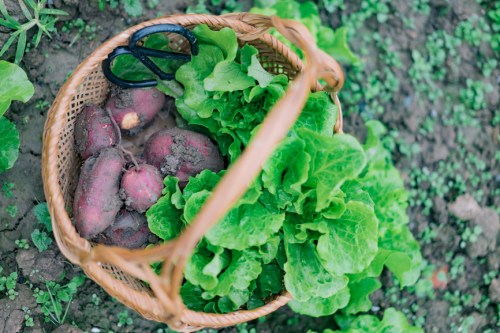Sweet Potatoes Are Surprisingly Easy (and Highly Rewarding) To Grow—Here’s How, in 4 Steps
Growing sweet potatoes just requires a sunny yard, well-draining soil, and regular watering. An urban farmer shares the basics.

Regularly praised by dietitians for their stellar nutrient profile, sweet potatoes are jam-packed with beta-carotene—which converts to immune-supportive vitamin A in the body—as well as fiber and potassium. In fact, the Japanese (aka purple) variety is eaten on the regular by some of the longest-living people in the world, in the Blue Zone region of Okinawa. It’s great news, then, that growing sweet potatoes is something you can most certainly do, whether you have a seasoned green thumb or are simply just beginning to consider starting an edible garden.
Experts in This Article
CEO and founder of Revival Roots, a company that builds and maintains vegetable gardens for Los Angeles locals
In fact, the perks associated with growing sweet potatoes extend beyond nutrition to the very health of your planting environment. In most gardens, sweet potatoes can actually help maximize growing space, says Reed Newman, an urban farmer and founder and CEO of Revival Roots, a Los Angeles-based company that builds and maintains vegetable gardens. (And that’s a particularly useful thing if you’re working within the confines of a raised garden bed or in any small space.) “They grow under the soil surface,” he says, “making them a perfect variety to intersperse with shallow-rooting vegetables, like lettuce, for example.”
“They grow under the soil surface, making them a perfect variety to intersperse with shallow-rooting vegetables, like lettuce, for example.” —Reed Newman, urban farmer
Not to mention, sweet potatoes are aesthetically pleasing while they grow, too, generating leafy-green foliage that’s both edible and serves as beautiful ground cover, Newman adds. Below, he shares the process for growing sweet potatoes, plus key tips for ensuring a bountiful harvest.
What to know before growing sweet potatoes
Generally, sweet potatoes are a sun-loving crop and grow well in warmer zones (in fact, they’re very heat- and drought-resistant). That said, there are a few short-season varieties that can thrive in northern regions, especially if you grow them in raised beds and cover them with black plastic in the case of an unexpected late-spring or early-fall frost. Furthermore, instead of seeds, sweet potatoes are usually grown from slips, says Newman. “These are small cuttings of a sweet potato, each including a single eye—one of those little dots you see on a potato’s skin.”
That said, you do want to ensure you plant a variety that works within your particular region and zone. (To find yours, consult the United States Department of Agriculture (USDA) Plant Hardiness Zone Map, which divides the country into zones based on average minimum temperatures, starting at Zone 1 for the coldest spots.) To help ensure you’re planting a viable variety, Newman recommends visiting a local nursery, which will typically only stock slips for sweet potatoes that perform well in your area. Or, scout online slip catalogs for types that include your zone in their descriptions.
Interested in going full DIY? You can actually create your own slips using sweet potatoes from a local farmer’s market. (The ones you’d find in a typical grocery store may be treated to prevent sprouting, so this planting process works best with organic tubers—and especially ones grown near you, so you can be sure that the particular variety is likely to thrive in your garden.) “All you need to do is cut out the eyes for a piece that measures 1 to 2 inches wide,” says Newman. “And make sure the cutting is about an inch deep to keep the eyes fully intact.”
How to grow and harvest sweet potatoes in 4 steps
1. Prep the soil and plant your slips.
Plan on planting your slips at least a couple weeks after the last frost in the late spring. Note that you’ll need a good three months of a hot growing season to allow the tubers to mature, so it’s important not to wait until too far into the summer to get started.
Since sweet potatoes grow beneath the soil’s surface, their roots need plenty of air space to reach down and secure nutrients. With this in mind, if your yard has compacted or clay-rich soil, consider planting them in a raised garden bed instead, using a sandy, well-draining mix. (You can also set up one of these on a patio or driveway, if you don’t have ample green space.)
And whether you’re planting in the ground or on a raised bed, you can start by turning your soil to loosen it, says Newman. “Ensure it looks fluffy and doesn’t have any big clumps. Then gently flatten the surface of the soil, and make divots three to four inches deep, with about one foot of space in between them.” You’ll place each slip in a divot with the eye facing up, cover with soil, and water enough to saturate the soil.
2. Water frequently and remove weeds.
Continue to water at least every other day, until the plant appears on the surface of the soil, or more frequently if you live in an extra-sunny area, regularly testing the soil with a finger to make sure it doesn’t fully dry out. Once you see sprouting green leaves, you can reduce watering to a couple times per week.
“As the plant matures, you can also harvest some of the edible green leaves,” says Newman. “They are a wonderful addition to a morning green smoothie. Just don’t harvest more than a quarter of the leaves at any one time to ensure the plant still produces plump sweet potatoes beneath the soil.”
If you notice weeds popping up in or around your sweet potato bed at week two or three, remove them regularly (but avoid any deep digging that could disturb the sweet potatoes’ feeder roots).
3. Dig up the tubers.
After 90 days have passed since the day you planted them, your sweet potatoes will likely be ready for harvesting. (If you see the leaves or ends of the vines turning yellow, that’s also a sign that they’re fully grown and waiting beneath the soil.) Loosen the soil around each plant, and carefully dig up the tubers by hand, pulling on the green foliage.
“You’ll be shocked by how much a single plant can produce,” Newman says. You can expect to find a bundle of anywhere between four and 10 sweet potatoes from just one slip, assuming you watered well and tended to weeds, and that your yard got a healthy amount of sunshine throughout the summer.
4. Don’t forget to cure them.
Once you have your homegrown sweet potatoes in hand, there’s one final step to take before they make it into your next casserole, roast, mash, or batch of cookies (yes, they’re delicious in baked goods). “Curing is what allows the sweet potatoes to store longer, and converts the taste from something starchy to that of the sweet root vegetable you are accustomed to,” Newman says.
To cure your bounty, place it in an 80°F to 85°F location for four to seven days. “You can put your sweet potatoes in a turned-off oven or on top of a warm radiator, for example,” says Newman. “Feel free to get creative.” After you’ve cured them, store your sweet potatoes in a cool, dark location until you’re ready to enjoy them.
Now that you know how to grow sweet potatoes, get more intel on their health benefits from an RD:
Oh hi! You look like someone who loves free workouts, discounts for cult-fave wellness brands, and exclusive Well+Good content. Sign up for Well+, our online community of wellness insiders, and unlock your rewards instantly.









